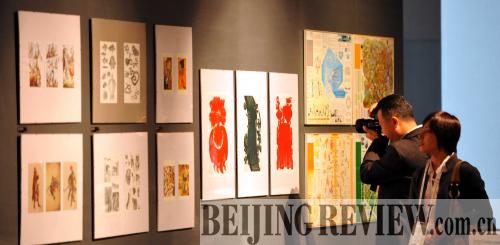|
 |
|
ART IN BOOKS: People visit The Most Beautiful Book—the Seventh National Book Design Exhibition at the National Center for Performing Arts (LUO XIAOGUANG) |
A chair with tree branches fixed on its seat. A puppet bear that could read English words. A honeycomb-like paper tent that could serve as a temporary room for a single person.
All these and more were among the design works from exhibitions at the 23rd Icograda World Design Congress (IWDC) held in Beijing from October 24-30.
This was the first time that China hosted the "Olympics" of the world design industry. Icograda stands for the International Council of Graphic Design Associations, which was founded in 1963 and is the world body of professional communications design. The first IWDC was held in Switzerland in 1964.
This year, more than 1,500 designers from 45 countries and regions gathered in Beijing with some 20,000 art works, which were displayed at 25 exhibitions.
The theme of the event was Xin, a Chinese character that can be interpreted as information, message, confidence and trust between people.
The art world
The 25 exhibitions covered almost all the areas of design, and depicted the most advanced design ideas from all over the world.
"We want to show to everybody that design art is not as difficult as many people think," said Wang Min, Vice Chairman of IWDC. "It is everywhere in our daily life."
A six-day concept exhibition on Chinese living style, entitled "Twelve Time Spaces," kicked off in the Digital Art Gallery of Beijing's World Art Museum on October 25.
The exhibition examined the relationship between design and life from the perspectives of both designers and the public. It equally explored the possibility of the designs that engage everyday life, while exploring how life enriches and uplifts design.
Set in virtual living space, the exhibition shows design's presence in everyday life—under day and night settings. Twelve designers involved in the exhibition created their own products based on different settings. All the exhibits were everyday products closely linked to people's lives.
In ancient times, a day was divided into 12 two-hour periods, and designers set their exhibitions according to their interpretation of different periods of a day.
Cai Zongzhi, the designer for the period lasting from 1 a.m. to 3 a.m., used the theme of his exhibition to represent dreams. "Normally that is the time for people to have dreams," he said. "So I used six dreams to show what I want to express."
With black as his basic color, Cai put chairs, desks, a sofa, perfume and even cars and diamonds in the exhibition. "Dreams can also be regarded as shadows of the soul," he explained. "And they are the reflection of real life."
Another exhibition, Design for Sitting, meanwhile, focused solely on chairs. It was a display of a chair-designing competition that advocates experimental design, local design and environment-friendly design. At the same time, 40 chairs made by designers from across the world were all on show. Visitors were able to sit on the chairs to feel and discuss the most comfortable and practical way of sitting.
In addition to daily-life design exhibitions, industrial design was also a big part of IWDC.
| 